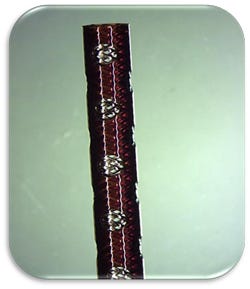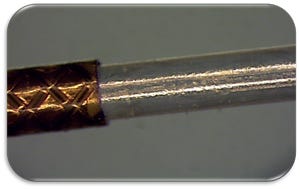6 Ways Laser Processing Can Overcome Braided Polymer Shaft Challenges
July 31, 2014
By Matt Johnson, Resonetics
Medical device engineers thrive on challenges, especially when they can arm themselves with highly-advanced technology to solve them. One of the toughest challenges is to machine braided polymer shafts, designed to have the flexibility to navigate through tortuous, often lengthy vasculature and the radial strength to avoid kinking or collapse. Laser micromachining offers the precision and capability to machine braided polymer shafts of a variety of different configurations and material types.
Braided polymer shafts consist of a woven material, typically stainless steel, which is thermally bonded to the surface of a polymer catheter. Often, there is an innermost polymer layer inside the metal braid. Each braided shaft design has a number of composition characteristics including type of material, number of layers, outside diameter, wall thickness, number of lumens, pic count and durometer. Any laser processing of the shafts has to take into account all of these characteristics.
Laser micromachining is a proven method for machining braided polymer shafts, offering the following advantages:
Intelligent--The process discriminates between soft polymer layers and hard metal braids, unlike most other processes;
Clean--Because it is a non-contact process, it minimizes damage or contamination compared to traditional methods such as grinding or mechanical drilling;
Economical--It's a cost-effective manufacturing process because it uses a large area beam or multi-beam process to reduce processing time;
Quality--It's also a high precision tool offering excellent repeatability, consistency and yield (even if the raw material has variation);
Precise--It possesses high resolution and tolerances that can be as small as 1 micron.
Due to the varied material type of the braided shafts and the order in which they are layered, different laser sources are needed for different shaft configurations. Selecting the right laser source (nanosecond, picosecond or femtosecond) is the first step, followed by the selection of the proper wavelength (UV, visible, infrared), machining method (mask projection, direct write) and process paramete
One of the interesting aspects of braided catheters is the unique composition of polymers and metals, which have very distinct chemical and physical characteristics. Although metals can be formulated to behave like polymers, and conversely, polymers can be formulated to have similar traits to metals, no one will deny that polymers and metals are vastly different. This dis-similarity presents challenges to many manufacturing methods that laser micromachining--in many cases--has overcome.
Here are six applications that incorporate laser micromachining to successfully process braided polymer shafts:
|
Selective laser ablation of polymer material. Image courtesy of Resonetics. |
1. Selective Laser Ablation of Outer Polymer Layer
Selective ablation of a specific location of a polymer-coated shaft is achieved by shaping the laser beam into a specific spot size (such as a 75mm long rectangular line) and ablating just that area. Patented homogenization technology greatly expands the laser beam size on target and guarantees +/- 5% energy uniformity, making laser micromachining a compelling and cost-effective manufacturing method.
Camera and machine vision systems help direct the laser to the right location, referenced from the edge of the shaft or the transition zone (unstripped to stripped region).
2. Controlled Depth Ablation
Controlled depth ablationcan be achieved by using a closed-loop end-point-detection method that detects material removal and discretely controls the laser dosage. This patented technique permits the partial ablation of a polymer layer to expose the top crests of the underlying braided shaft. This method can also be used for ablating 100% of a polymer coating from a thermally-sensitive metal braid that cannot withstand over-pulsing. Closed-loop manufacturing processes guarantee process repeatability and maximize yield, even if there is lot-to-lot material variability. Widening a process window reduces manufacturing cost and increases overall quality.
Using machine vision and multiple lighting schemes, the laser can drill in-between the checkerboard pattern of a polymer-coated metal braid without touching the edges of the braid. Despite the variations in the size of the braid opening and spacing, intelligent machine vision provides real-time data to the laser controller to place the laser beam in the right location.
3. 100% Ablation to Expose Underlying Metal Braid
|
Laser ablation removing all polymer material. Image courtesy of Resonetics. |
Some of the most challenging cases are when the laser must selectively machine a polymer without affecting the underlying metal, or when it's necessary to machine metal without disturbing the underlying polymer. This requires precise process control, much like a surgeon's fine touch to use a scalpel to expose the tissue layer-by-layer. As an example, a laser can remove polyimide from a braided shaft while leaving the metal completely untouched and 100% void of debris. The laser is able to accomplish this because the two materials have dissimilar characteristics. The ablation threshold to etch a polymer is an order of magnitude less than to ablate metal. Once the laser has etched through the polymer laser, the beam can hit the metal layer for additional pulses (+10%) without any damage. Precautions are also taken to minimize discoloration and to eliminate any heat affected zone (HAZ) that may occur from beam scatter off the metal braiding.
4. Laser Cutting Polymer Coating and Metal Braid
Laser micromachining a composition of polymer and metal is a significant technical challenge. In order to drill through the polymer-coated metal braid, the laser must operate at high fluence (energy density) to cut through the metal, but this intensity will undoubtedly melt the polymer. If the laser intensity is reduced, then the laser drills through the polymer without melting, but the laser may not have enough intensity to cut through the metal. Proprietary laser micromachining techniques solve this issue using novel laser sources and closed-loop processes. As an example, early detection of the next material type could tell the controller to slow down the laser repetition rate or decrease the intensity or conversely, the opposite command could be given. Cryogenic cooling methods could assist in minimizing thermal damage when laser ablating polymers while still having the intensity to cut through the next metal layer.
5. Laser Cutting Polymer Coated Metal Braid, Not Innermost Polymer Layer
|
Rotational laser-cut polyimide and stainless steel braid leaving PTFE untouched. Image courtesy of Resonetics. |
An even more challenging application is to laser-cut through a polymer-coated braid but not touch the innermost polymer layer, such as PTFE. The PTFE liner creates a very smooth non-reactive inside diameter surface and helps maintain the flexibility of the braided shaft. The laser must not melt the outer polymer coating, yet it must be intense enough to cut through the metal braid and not harm the supporting polymer material below. Contending with three dissimilar boundary conditions of varying material and optical properties--with varying energy levels at which the molecular bonds will break--requires careful selection of the right laser wavelength, pulse duration and process parameters.
6. Laser Drilling all Layers
In addition to all the choices for laser cutting, you can also laser-drill through the outermost polymer layer, the metal braid and the innermost polymer layer. In this process, lasers can drill through a tri-layer of polymer/metal/polymer with minimal melting of polymer and debris (slag) along the edges of the metal braid. This process is similar to drilling a bi-layer of polymer and metal.
Take precautions, however, to minimize the debris coming out the backside, as this is not acceptable for many applications. Gas assist, debris extraction and flushing are a few examples of methods that can help contain or eliminate debris.
Refresh your medical device industry knowledge at MEDevice San Diego, September 10-11, 2014. |
In Summary...
The complexity of braided polymer shafts poses a manufacturing challenge for the medical device community. The distinct properties of polymers and metals, increasingly arranged in composite, layered configurations requires a manufacturing technology that must discriminate between them while precisely controlling the depth and location despite variation in coating thickness, pic rate, braid opening size and inside diameter. Laser micromachining is a compelling, cost-effective, repeatable and consistent process to solve product development challenges and to scale up for volume manufacturing.
Matt Johnson is an application engineer at Nashua, NH-based Resonetics.
About the Author(s)
You May Also Like




.png?width=300&auto=webp&quality=80&disable=upscale)
